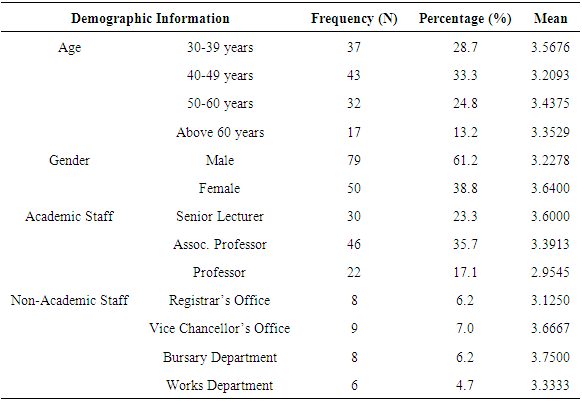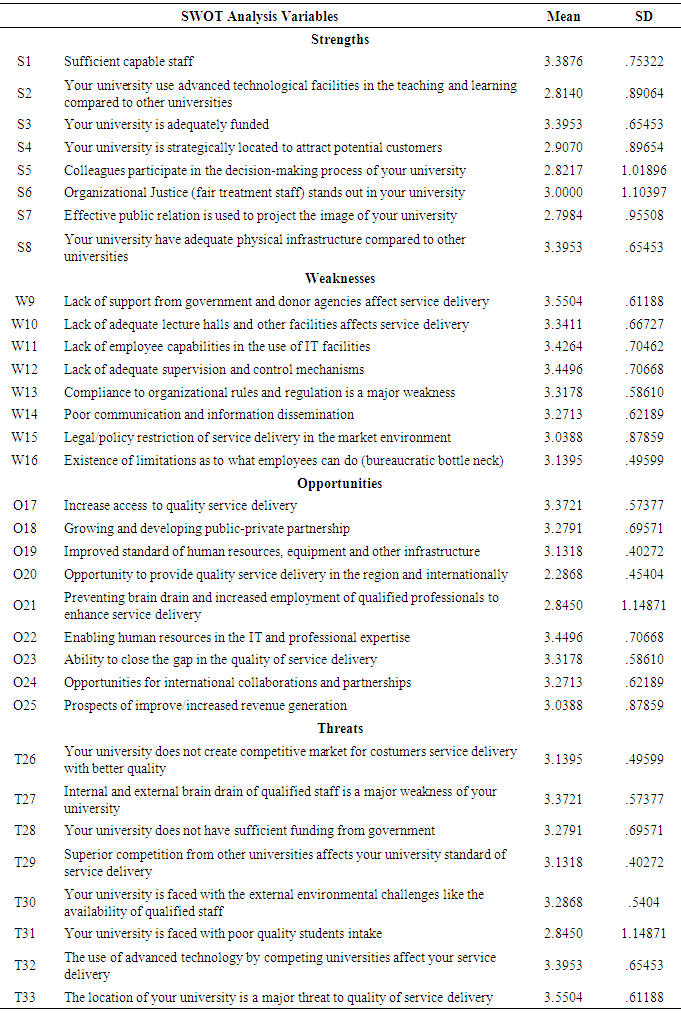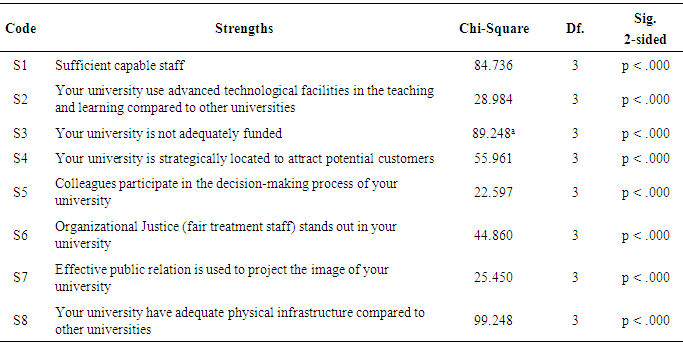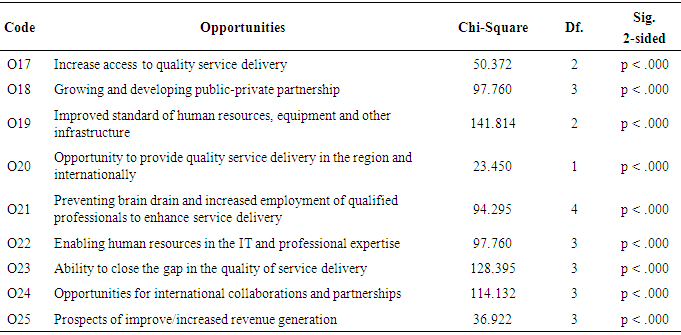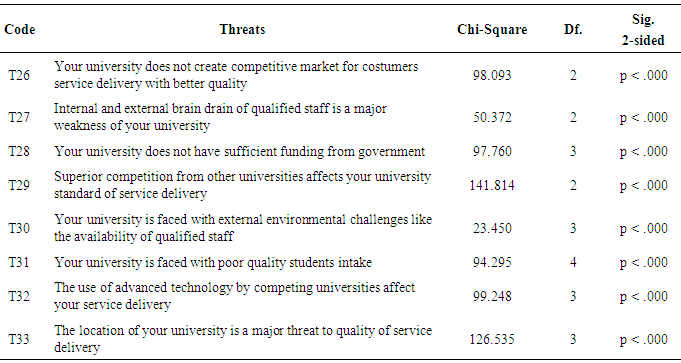-
Paper Information
- Paper Submission
-
Journal Information
- About This Journal
- Editorial Board
- Current Issue
- Archive
- Author Guidelines
- Contact Us
Management
p-ISSN: 2162-9374 e-ISSN: 2162-8416
2016; 6(3): 76-88
doi:10.5923/j.mm.20160603.03

Strategic Planning: A Universal Remedy for the Successful Management of 21st Century University Education (UE)
Nwachukwu Prince Ololube1, Fidelis Aiya2, Oboada Alafonye Uriah1, Dennis Ogutum Ololube2
1Department of Educational Foundations and management, Faculty of Education, Ignatius Ajuru University of Education, Port Harcourt, Nigeria
2Department of Public Administration, Faculty of Management Sciences, Ambrose Alli University, Ekpoma, Nigeria
Correspondence to: Nwachukwu Prince Ololube, Department of Educational Foundations and management, Faculty of Education, Ignatius Ajuru University of Education, Port Harcourt, Nigeria.
| Email: |  |
Copyright © 2016 Scientific & Academic Publishing. All Rights Reserved.
This work is licensed under the Creative Commons Attribution International License (CC BY).
http://creativecommons.org/licenses/by/4.0/

Universities globally unquestionably encounter a number of significant problems and they stay in the race to struggle with the implementation of programs to guarantee quality research, teaching and learning. The purpose of this article was to evaluate the role of strategic planning for successful management of the 21st century university education (UE). This article employed document and quantitative approaches for information gathering and analyses. The study revealed noteworthy relationship between strategic planning vis-à-vis SWOT analysis and successful university management. The paper concluded that in spite of the increasing difficulty in universities leadership created by lack of adequate planning and rising students’ enrollments, universities should work towards ensuring that they improve their students and society at large. As a result, educational planners need to incorporate strategic planning processes to the benefit of both the universities and society. This paper benefits university leaders and strategists on the way forward toward strategic planning of university systems world-wide.
Keywords: Education Planning, Management, Success, University, 21st Century, SWOT Analysis, Strengths, Weaknesses, Opportunities, Threats, Benefits
Cite this paper: Nwachukwu Prince Ololube, Fidelis Aiya, Oboada Alafonye Uriah, Dennis Ogutum Ololube, Strategic Planning: A Universal Remedy for the Successful Management of 21st Century University Education (UE), Management, Vol. 6 No. 3, 2016, pp. 76-88. doi: 10.5923/j.mm.20160603.03.
Article Outline
1. Introduction
- University Education (UE) is a fundamental right for those who can afford it financially; it helps to ensure a safer, healthier, advanced, prosperous, naturally comprehensive and great world. UE at the same time can contribute to political, social, economic, technological and cultural development (Gbenu, 2012). However, uncertainties trail university systems globally, and strategic planning is arguably a remarkable task aimed at addressing the uncertainties (Ololube, 2013). It becomes considerably more frightening when it raises its head in an uncertain social, political, technological and economic environment confronting present day UE. The uncertainties in a nation’s university systems, combined with other institutional inadequacies, might be grossly responsible for failures in the achievement of educational goals (Ajake, Oba & Ekpo, 2014). These worries have the potential to inhibit UE production in most third world countries, particularly in Nigeria (Ololube, 2013). Over four decades, these fears are obvious because they affect the human and material resources base of a nation’s university systems. Generally, the major problems affecting universities in Nigeria are poor management and control of educational programs, training and retraining of staff for capacity building (Ramsey & Wesley, 2015; Ololube & Kpolovie, 2013), the selection and organization of curriculum content, curriculum implementtation and evaluation (Ajake, Essien & Omori 2011; Obanga, 2012), the development, distribution and use of ICT-based instructional materials (Ololube et al., 2013), and the relevance of the curriculum to the needs of the society (Ajake, Oba & Ekpo, 2014). Not unexpected, there is also the problem of poor motivation and discipline (Adeniyi, 2001). Strategic planning is a determining factor in the quality of university as reflected in students', faculty (lecturers) and administrators’ performance (Ololube & Kpolovie, 2013; Hénard, 2012). Thus, it is obvious that the parameters that impact the level of the quality reached in educational production are essentially driven by strategic planning (Adeyemi & Oguntimehin, 2000; Ololube, 2013).Several academics (e.g., Adeniyi, 2001; Ejumudo, 2013, Ike, 2015; Uriah, Ololube & Ololube, 2016) in their respective works discussed the crises and problems facing education in developing countries (Nigeria in particular). These problems are not atypical to developing countries. Universities in developed countries equally compete for public funds with other segments of their national economies (Ololube & Kpolovie, 2013). The objectives for the establishment of universities can be achieved when resources are made available and put into maximum use. Strategic planning progressed as a discipline to guide the distribution, allocation and utilization of resources in educational institutions (Okoroma, 2006), because integrated planning activities helps to minimize waste of resources and make educational production more effective (MSG, n.d). Integrated planning in this context is the linkages between vision, mission, primacies, people, and the physical institution in a flexible system of evaluation, decision-making and action. It shapes, guides and directs the entire university system as it evolves over time and within the communities they operate (Hinton, 2012). To this end, strategic planning is central in the management of university systems in order to achieve their desired goals globally (Altbach, Reisberg & Rumbley, 2009). The strategic planning process in a university is the output of the plan itself (Agabi & Ogah, 2010). It is a blueprint of action that describes the activities needed for the university to realize its goals (Hinton, 2012). Therefore, the purpose of strategic planning in a university is basically to ensure that the system is effective in its activities (Ololube, 2013). Generally, a university system must develop plan that ensures that the appropriate products and services are offered to its students and society (Hénard, 2012). To be more precise, strategic planning gives guidance and direction to members of an organization with particular emphasis to their role of products and services delivery (McNamara, 2016), it is the process of applying scientific or rational procedures to the process of growth and development to ensure the efficiency and effectiveness of the informative system through strategic planning mechanism (Ololube, 2009a). In strategic planning mechanism, once the achievability of a proposed service had been established a number of specific actions are necessary in order to guarantee that an operational service could develop into reality (Agi & Adiele, 2009; Richardson, 2004).
1.1. Background (Strategic Planning Process)
- The abovementioned characterizations of strategic planning suggest that strategic planning is a process. This means that activities are drawn up and systematically analyzed, policies formulation for implementation and control. A strategic plan is described to be effective if the resources put into it are adequate in meeting the specified objectives. An effective strategic plan is one in which the preferred objectives have been achieved (Olaniyonu, Adekoya & Gbenu, 2008). It is essential for educational production to be well-organized and effective if it is to accurately guide the internal modifications in the university as it utilizes the resources available. In the same vein, a university strategic planning provides a basis for all of its activities, and the process that outlines the activities that are essentially required to achieve the goals of UE (Hinton, 2012). Through strategic planning, educational planners regulate and determine how education resources are to be distributed, and how the activities of the UE system will be assigned to individuals and work groups (Chance & Williams, 2015). Therefore, university strategic plan is a neat and cautious attempt, through structured and continuous processes that identify the diverse elements and characteristics of the UE. It helps in defining the current position and interaction in the UE systems, hence projecting them throughout a specified period of time. This is done by analysing the present situation, formulating of policies, implementing the policies and controlling the actions that have evolved to get the preferred aims and objectives of UE. It focuses on improving the competitive circumstances and the overall performance of faculty and students (Ololube, 2013; Ololube & Kpolovie, 2013). The history of strategic analysis and/or planning began in the military (Carpenter, 2005). Dictionaries define strategy to mean the art of planning and directing, which may include extensive managerial operations within an organization. Although the understanding of strategy as it is applied in management has been transformed, however, one element remains protuberant: the purpose to attain competitive advantage. Taking its name and roots from the military classics, early strategic planning relates to the hierarchical ideals and the linear systems of traditional organizations, undertaken by superlative planning role at the top of the organization; its structure was highly vertical and time-bound. A definite period would be set aside to evaluate the circumstances and agree on a course of action to take. Once this was ready the actual work of implementation (Rajasekar & Al-Raee, 2014), which is considered a discrete process could begin (Wall & Wall, 1995). Although individual characterizations of strategy vary between authors, traditionally, theorists consider strategic planning to be an essential part of organizational strategy (Ololube, 2009a). Therefore, it is safe to say that a university’s strategic planning is the process by which it makes decisions and take actions that affects its long-term performance, which is said to be an output of the planning process. It defines both the faculty in the university and the students in relation to the teaching and learning processes (Chance & Williams, 2015). The feedback process (Figure 1) is a model in which universities may need to cycle back to a previous stage in the strategic planning process thereby creating room for adjustments when the need arises (Ololube, 2013).
 | Figure 1. Feedback Process |
1.2. Purpose of the Study
- This text chronicles the findings of a research that studied strategic planning as a tool for the successful management of 21st century UE in the South-South Nigeria, with a special focus on SWOT analysis, vis-à-vis strengths, weaknesses, obstacles and threats. The uncertainty in the academic environment in Nigeria has been suggested as being responsible for the slow growth rates in Nigerian UE. However, effective planning through the use of strategic analysis is progressively taking place in UE especially in private universities in Nigeria.Internet searches have shown that there are no empirical studies on strategic analysis as a tool for effective university management, with special application to the university system. This ground-breaking investigation is intended to enlarge our understanding and proves to be a valuable addition to the theme of this study. The passion to carry out this study rose from the authors desire to examine how best university leaderships analyze their strengths, weaknesses, opportunities and threats to the advantage of their institutions.To address the stated objectives of this paper, the general assumption statements presented in this study are: there is evidence that perceived use of SWOT analysis is strongly connected with ease in the management of universities. The same seems to be true to reflect how university leaderships effectively analyse the internal (strengths and weaknesses) and external (opportunities and threats) environment situation to extend development in universities. Thus, subsequent to the above postulations, it is safe to specifically hypothesize that:§ Organizational strengths are not significantly related to the successful management of 21st century university education. § Organizational weaknesses are not significantly related to the successful management of 21st century university education. § Organizational opportunities are not significantly related to the successful management of 21st century university education. § Organizational threats are not significantly related to the successful management of 21st century university education.
2. Literature Review
2.1. Strategic Analysis
- This is the principal stage of the strategic planning process, which is aimed at evaluating the present condition of a university. That is, it requires a detailed assessment of the university’s internal and external environment. The purpose of strategic analysis in the university planning process is to identify the university’s assets, skills, and resources that represent strengths, weaknesses, opportunities and threats (SWOT). Strengths are favourable internal features that the university can apply to accomplish its strategic aims. Weaknesses are internal facets that hinder or limit goal accomplishment. Opportunities are features of the external environment that will cause the university to realize its aims and objectives if it cannot resist or avoid them. Threats are features of the external environment that might favour the university provided it is able to take advantage of them (see, Mason, 2007; Naylor, 1999). The focus here is that strategic analysis looks at the present position of a university. The principal idea in this study is that in applying SWOT analysis into Nigeria’s UE will go a long way in solving the ever-complex strategic management scenario facing university leaderships instead of scavenging for thoughts. SWOT Analysis is a simple framework for generating alternatives from situation analysis. It is relevant to either the corporate level or business unit level and frequently appears in UE administration plans. Universities in the west use this form of analysis because it focused on the issues that could potentially have the most impact (Mason, 2007). SWOT analysis is useful when a precisely limited amount of time is available to address a complex strategic situation (ICMBA, 2004). Figure 2 indicates how SWOT analysis fits into the strategic analysis of university systems. SWOT analysis produces a huge amount of information about the internal and external situation analysis of an organization.
 | Figure 2. SWOT Analysis |
2.2. Strategic Formulation
- If the strategic analysis is completed and the current position of the university is recognized, the next step is to look at where the university wants to be. It now follows that the mission of a university (the rationale for which the university exists) has to be established. It involves setting strategic goals (the results that the university seeks to achieve in the long-term), identifying strategic alternatives as well as evaluating and choosing the strategy that provides the optimum performance of the university in a long term. This idea is in line with what ICMBA (2004) opined when they emphasized that when a clear picture of an organization and its environment is in mind, specific strategic alternatives can be developed. While different organizations have different alternatives depending on their present situation, there is also the existence of generic strategies that can be applied across a wide range of organization. ICMBA (2004) cited Michael Porter who identified cost leadership, differentiation, and three generic strategies that may be considered when defining strategic alternatives. Porter (1991) advised against implementing a combination of these strategies for a given product instead he argued that only one of the generic strategy alternatives should be pursued (see, Datta, 2009; Amagoh, 2008).
2.3. Strategic Implementation
- After strategic formulation comes the implementation stage and the best-formulated strategy is unworkable or worthless if it cannot be implemented effectively (Ololube, 2013). If the university is to achieve the best result for which it was established through its strategic planning efforts, it must make sure that its strategy is put into action (Ololube & Kpolovie, 2013). The underlying idea here is to ascertain how the university can get to where it wants to be. The strategic planning process is a critical stage in the history of Nigerian universities: implementation has been inconsistent and inadequate data as well as incompetent and skilled personnel inhibit the planning process in most cases (Ololube, 2013). However, if a choice has been made on the strategy to use, according to ICMBA (2004), the strategy likely will be expressed in high-level terms and priorities. For effective implementation, it needs to be translated into more detailed policies that can be understood at the functional level of a university (Ololube, Agbor & Kpolovie, 2016). The expression of the strategy in terms of functional and serviceable policies also helps to highlight practical issues that may not have been visible at a higher level. For effective implementation of a strategic plan, the policies should be translated as much as possible into specific policies for the functional level line staff in the university (academic and non-academic) to understand the purpose for which the plan is been carried out.
2.4. Strategic Control
- This is the final stage of the strategic planning process. Strategic control involves the monitoring of the implementation process thereby ensuring that it is in line with the expected performance. An effective university control system should be able to pinpoint and identify the strengths and weaknesses that characterize the planning process and alert the planning unit, policy/decision makers who then make possible modifications. The fundamental idea here is determining how a university would know the moment it has arrived (Ololube, 2004; 2006a,b).The reason universities needs planning is vital at this stage of our discussion, becaus there are numerous unavoidable problems that face the university system in Nigeria (Alabi & Okemakinde, 2010; McNamara, 2016). One of such problem is the rising demand for UE and thus the increasing number of student’s enrolment. Li (2013) argued that the expanding request for UE is necessitated to a large extent by the changes in the kinds of occupations produced in maturing economies.
3. Methods
3.1. Study Design and Setting
- This study is a cross sectional study and was carried out in three public universities in the South-South geo-political zone of Nigeria (see figure 3).
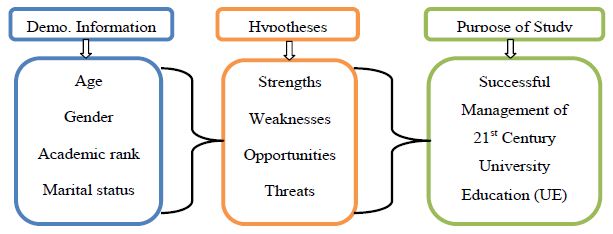 | Figure 3. Study design and setting summarised |
3.2. Target Population
- The target population of this study were senior tenure track faculty members and senior management staff of selected public universities in the South-South geo-political zone of Nigeria.
3.3. Sampling Design
3.3.1. Sample Size
- In this study, the respondents comprised 98 academic staff and 31 non-academic staff of the three selected universities. See table 1 for details of the respondents’ demographic information.
|
3.3.2. Sampling Technique
- A purposeful and stratified random sample procedure was carried out. The stratification was based on the faculties in the selected universities. The selection of universities was carried out proportional to the numbers of public universities in the region. All selected respondents agreed to participate in the study by filling out the questionnaire giving a response rate of 100%.
3.4. Data Collection
- The data for this study were collected by the researchers through anonymous self-administered questionnaires. The questionnaire was designed and validated by experts in the measurement and evaluation departments of the three universities. The questionnaires were distributed to the respondents in their offices. The purpose of the study and the importance of conducting the research and the instruction on how to fill the questionnaires were explained. The questionnaire comprised five sections, section 1 included information on the respondents demographic information; section 2 deals with issues of organizational strength; section 3 talked about variables on organizational weaknesses; section 4 relates to issues on organizational opportunities; while section 5 highlighted on issues of organizational threats. The questionnaire was structured along 5-Point Likert scale: 1=strongly disagree, 2= somewhat disagree, 3=N/A, 4=somewhat agree, and 5=strongly agree.
3.4.1. The Section of the Questionnaire
3.4.1.1. Section 1: Demographic Information
- This section included respondents’ demographic variables such as age, gender, academic staff, and non-academic staff.
3.4.1.2. Section 2: Organizational Strengths
- Section 2 deals with variables of organizational strength that can serve as foundation for building competitive advantage, better influence its management that can correct their weaknesses and take advantage of excellent opportunities, and possibly prevent devastating threats. This section is aimed at investigating staff perception of the university strength that can build healthy components of effective university administration. It consisted of 8 questions. This section’s Cronbach’s alpha reliability analysis is .817.
3.4.1.3. Section 3: Organizational Weaknesses
- This section consists of the internal situation analysis of an organization with particular reference to its visible weaknesses. The section is aimed at examining staff perception of university weaknesses that can hinder healthy university administration and development. It comprised 8 questions. This section’s Cronbach’s alpha reliability analysis is .791.
3.4.1.4. Section 4: Organizational Opportunities
- Section 4 relates to the opportunities a university has to introduce new products or services that can generate great benefits and profits. These external factors may be the reason a university may develop. The section is designed to examine staff perception of university opportunities that can propel vibrant university administration and development. It comprised 9 questions. This section’s Cronbach’s alpha reliability analysis is .708.
3.4.1.5. Section 5: Organizational Threats
- This section highlighted the external environmental factors that might threaten a university’s well-being. They are peripheral factors that are beyond a university’s control, which may possibly place the university at risk of failure. It consists of list of possible threats that staff adjudge may conceivably have negative influence on effective university administration and development. It comprised 8 questions. This section’s Cronbach’s alpha reliability analysis is .836.
3.5. Statistical Analysis
- The statistical analyses in this study were carried out using SPSS version "21" of a computer program. The following statistical analyses were performed:§ Descriptive statistics (mean and standard deviation)§ Chi-square goodness of fit was used to determine the relationship between variables§ Cronbach’s alpha reliability analysis
3.5.1. Dependent Variable
- This includes the internal (strengths and weaknesses) and external (obstacles and threats) environment variables, and the significant scores from Chi-square goodness of fit analysis was computed and the level of significance was set at P-value < 0.05.
3.5.2. Independent Variables
- Demographic variables and scores for age, gender, academic rank, and marital status was conducted (descriptive statistics: mean and standard deviation).
4. Results/Discussion
- Building on the purpose of this study’s hypotheses, the hypotheses were formulated in line with the questionnaire developed and it provided answers to the specific items in the questionnaire:Hypothesis 1: Organizational strengths are not significantly related to the successful management of 21st century university education provided answers to items (S1, S2, S3, S4, S5, S6, S7 and S8).Hypothesis 2: Organizational weaknesses are not significantly related to the successful management of 21st century university education provided answers to items (W9, W10, W11, W12, W13, W14, W15 and W16). Hypothesis 3: Organizational opportunities are not significantly related to the successful management of 21st century university education provided answers to items (017, 018, 019, 020, 021, 022, 023, 024 and 025). Hypothesis 4: Organizational threats are not significantly related to the successful management of 21st century university education provided answers to items (T26, T27, T28, T29, T30, T31, T32 and T33).
4.1. Descriptive Statistics (Mean and Standard Deviation)
- The second statistical procedure carried out in this study was an analysis of respondents’ answers using mean and standard deviation. The results revealed the extent respondents perceived SWOT variables (strengths, weaknesses, opportunities and threats) in relation to successful management of 21st century UE in Nigeria. Results in Table 2 revealed that all the respondents agreed that Nigeria has to do more to guarantee successful university management that would foster operational research, teaching and learning.
|
4.2. Hypotheses Testing (Chi-Square Goodness of Fit)
4.2.1. Organizational Strength
- To further substantiate on the descriptive statistical analysis conducted, the researchers’ employed Chi-square goodness of fit analysis to determine whether relationships exist in staff perception of the variables tested and also to find out whether the mean of a normally distributed population has a value specified in null hypothesis 1. The respondents were of the opinion that for there to be successful management in the 21st century UE in Nigeria, the internal factors (organizational strength) need to be strategically improved and sustained. Thus, strengths are the greatest asserts of a university system. The results revealed a significant relationship among the variables (S1-S8) based on the respondents’ perceptions. All the variables tested depicted relationships (p < .000), two-sided. This does not mean that the probability is 0. It is less than p < .0001. The highest X2 value was 99.248 and the lowest was 22.597 with a df = 3 for all the items (the details are as presented in Table 3).
|
4.2.2. Organizational Weaknesses
- To further demonstrate on the relationship between organizational weaknesses and successful university management in the 21st century, a Chi-square goodness of fit analysis was accompanied to determine whether relationships exist in staff perception of the organizational weaknesses variables tested and if the normally distributed population has a value indicated in null hypothesis 2 (the details are as presented in Table 4). The respondents were of the opinion that for there to be successful management in the 21st century UE in Nigeria, the internal factors (organizational weaknesses) need to be strategically improved to reduce its impact on the management of university system. Thus, they agree that organizational weaknesses impede and hinder the successful management of UE. The results exposed a significant relationship among the variables tested (W9-W16) following the respondents’ perceptions. All the variables tested depicted relationships (p < .000), two-sided. This does not mean that the probability is 0; what it means it is less than p < .0001. The maximum X2 value was 128.395 and the lowest was 36.922 with a df =3 for all the items.
|
4.2.3. Organizational Opportunities
- Chi-square goodness of fit analysis weighted organizational opportunities in order to appraise the relationship between organizational opportunities and successful university management in the 21st century. The analysis was aimed to define whether relationships exist in staff perception of the organizational opportunities factors tested and whether the distributed population has a value identified in null hypothesis 3 (the details are as presented in Table 5). The respondents hold that the successful management of university UE in the 21st century is significantly related to the opportunities the universities are exposed to. The external factors (organizational opportunities) need to be advantageously grabbed to enhance the successful management of UE. Overwhelming majority of the respondents agree that organizational opportunities if properly utilized will drive the successful management of UE. Thus, the results exposed to view that there are significant relationship between organizational opportunities and successful university management. All the variables tested (O17-O25) depicted significant relationships at (p < .000), two-sided.
|
4.2.4. Organizational Threats
- Chi-square goodness of fit analysis was conducted to determine whether significant relationships exist in respondents’ perception of the external factors (organizational threats) tested and the mean of the distributed population has a value definite in null hypothesis 4. The perception of the respondents revealed that for there to be successful management in the 21st century UE, the external factors (organizational threats) need to be deliberately watched and tackled. Thus, organizational threats are the greatest challenges of a university system. Thus, the results exposed to view that there are significant relationship between organizational threats and successful university management. All the variables tested (T26-T33) showed significant relationships at p < .000, two-sided. This does not mean that the probability is 0. It is less than p < .0001. The highest X2 value was 141.814 and the lowest was 23.450 with a df = 2, 3 and 4respectively (the details are as presented in Table 6).
|
5. Conclusions
- In this study researchers measured and examined perspectives on strategic planning as a universal remedy for the successful management of 21st century university education (UE) by using SWOT analysis to determine the place of organizational strengths, weaknesses, opportunities, threats in university management. This study supports the need to promote research, teaching and learning processes through strategic improvement and sustained efforts to strengthen UE. Weaknesses found in the university need to be strategically improved to reduce their negative impact on the management of university system, as much as it is expected that the external opportunities available to the universities need to be advantageously grabbed to enhance the successful management of UE, and the organizational threats need to be deliberately watched and tackled to reduce their impact on successful management of UE. In summary, university management that find themselves in a difficult and turbulent environment should be proactive and concentrate on creating an internal environment conducive to co-evolution (Mason, 2007).This research has both practical and conceptual implications for university management. Web searches and the results from this study has demonstrated that this empirical study is unique in Nigeria and has added to the emerging body of knowledge in the field. As such, this study provides backing to researchers and practitioners. This study also has implications for university planners, government, administrators, policymakers and a wide range of other players involved in university effectiveness practitioners, quality improvements players, and sustainable development advocates of education in Nigeria in particular, and Africa in general. The findings of this study confirm that studies on strategic planning as a universal remedy for the successful management of 21st century university education (UE) need not stop at this stage. This ground-breaking investigation is not an end in itself, but rather an important starting point for ongoing research in this domain. In closing, the successful inclusion of organizational strengths, weaknesses, opportunities and threats into the strategic planning of UE can make important contributions to achieving successful university management. Nevertheless, the limitations of this research might be that the opinions of 129 respondents out of thousands of academic and non-academic staff in Nigeria cannot be considered all-inclusive or comprehensive. Subsequently, researchers are encouraged to use the framework of this study to further investigate issues of university management.
 Abstract
Abstract Reference
Reference Full-Text PDF
Full-Text PDF Full-text HTML
Full-text HTML